How did the United States’ motivations for entering World War II impact our actions?
Following World War I, the United States hoped to avoid further entanglement with European politics that had drawn us into war. A strong isolationist sentiment developed that questioned the wisdom of our entry into The Great War as it was then known. However, the rise of military government in Germany, Italy and Japan and their invasions of neighboring countries became a major concern for United States leaders including President Franklin Delano Roosevelt.
Germany Instigates World War I
In Europe, Adolf Hitler led the rise of the Nazi Party, which claimed that Germany was treated unfairly in the peace treaty that ended WWI. He also sought to unite all German-speaking peoples, a policy that put him at odds with several neighbors like Austria, Poland and Czechoslovakia. Great Britain and France tried to negotiate an end to German expansion, but the Soviet Union on Germany’s eastern front signed a non-aggression treaty with Hitler that opened the door to Germany’s invasion of Poland in 1939. France and England came to the aid of the Poles and declared war on Germany. Hitler’s armies quickly overran Poland and then France, leaving Britain alone against German armies and air force. President Roosevelt wanted to come to the aid of our British allies, but public sentiment was not yet ready to send American soldiers to fight in another European war.
Meanwhile, Germany and Italy became partners with Japan that had designs on domination of Eastern Asia. Japan lacked natural resources like oil and rubber and created plans to attack neighboring countries that could supply them. They invaded Korea and Manchuria and then China. They also looked southward to the European colonies of Dutch East Asia and British Malaysia. They knew that the United States and Great Britain would fight to stop them. To weaken U.S. naval forces in the Pacific, Japan bombed the naval base at Pearl Harbor in Hawaii on December 7, 1941. America declared war on Japan, and on December 11, Germany and Italy lived up to their agreement with Japan and declared war on the United States. Iowan Henry A. Wallace had been elected vice president in 1940 and served there throughout most of the war.
American Offensive in European and Pacific Fronts
Instead of putting all its efforts to fight Japan, the United States made Europe its first priority. Roosevelt met with Winston Churchill, the British prime minister, and they agreed that Hitler was a greater danger than Japan. German planes were bombing London regularly, and many expected a Nazi invasion. The United States began mobilizing armies, converting its factories to produce war supplies, and encouraging farmers to boost production. British and American generals developed a plan to invade Europe through Italy before attempting an attack across the English Channel against heavily fortified defenses. Meanwhile, German armies had invaded the Soviet Union and were imposing frightening losses on military and civilian populations alike. The Soviets, with the aid of a brutal Russian winter, halted the Nazi advance and forced a German retreat. Finally, in June 1944, a combined American-British invasion force landed on the French coast of Normandy, established a beach head, and from there began an offensive that led to a German surrender in May 1945.
Meanwhile, the U.S. Navy took the offensive in the Pacific against Japan. The route to Japan led through several Pacific Islands that the Japanese defended with determination. Two Allied naval victories broke the strength of the Japanese fleet and allowed the Allied forces to get close enough to establish air bases from which bombers could strike Japanese cities. The estimates of the loss of life that would be required to force the main Japanese islands to surrender reached a million. During the war, in a very secret project, U.S. scientists had developed a bomb that was hundreds of times more powerful than anything before. In August, 1945, President Harry Truman ordered atomic bombs to be dropped on the cities of Hiroshima and Nagasaki, bringing the world into the nuclear age. Japan surrendered within a matter of days, and WWII was over.
Some estimates of the loss of life due to fighting, disease and other war-related factors run as high as 60 million, or about 3 percent of the world's population at the time. The Soviet Union suffered the greatest cost, with some 20 million civilian and military casualties. The United States, protected by two oceans from the battlefields, sustained around 420,000 war-related deaths. Iowa soldiers killed or wounded are recorded as around 2,800.
Supporting Questions
Why did the US get involved in World War II?
- "Their Cry is Answered," July 25, 1940 (Image)
- Atlantic Charter, August 14, 1941 (Document)
- USS West Virginia on Fire during Attack on Pearl Harbor, December 7, 1941 (Image)
- President Franklin Delano Roosevelt's "Day of Infamy" Speech, December 8, 1941 (Document)
- "United States Is At War But Citizens Are Calm" Newspaper Article, December 10, 1941 (Document)
- "Many Local People in Pacific War Zone" Newspaper Article, December 11, 1941 (Document)
- "Warning Our Homes Are In Danger Now," 1942 (Image)
- "The Unconquered People" Sketch, July 1942 (Image)
- "Remember Pearl Harbor - Work - Fight - Sacrifice!!" 1943 (Political Cartoon)
- "Roosevelt and Hitler" Buster Ezell's World War II Song, March 1944 (Document)
Why did America fight differently in the two theaters?
- Destruction of a Burmese Village after a Japanese Bombing, ca. 1942 (Image)
- Japanese Plane Carrier Circling to Avoid Attack at Midway, ca. 1942 (Image)
- Memo from Joseph Stalin about Opening of Second Front during World War II, August 13, 1942 (Document)
- Allied Civilian Relief in Tunisia, 1943 (Image)
- Australian Troops Fighting the Japanese in Buna (New Guinea), 1944 (Image)
- D-Day Statement to Soldiers, Sailors, and Airmen of the Allied Expeditionary Force, June 1944 (Document)
- American Troops Move Through a Bombed German Street, April 16, 1945 (Image)
- Interview with Merrill's Marauders Commando Grant Jiro Hirabayashi, June 29, 2005 (Video)
- Interview with Conscientious Objector Rothacker Smith, March 24, 2006 (Audio)
How was victory achieved on each front?
- Nagasaki, Japan, After the Atomic Bomb, 1945 (Image)
- General Leslie Groves' Statement to the Officers about the Atomic Bomb, 1945 (Document)
- German Instrument of Surrender, May 7, 1945 (Document)
- Petition from Leo Szilard and Other Scientists to President Harry S. Truman, July 17, 1945 (Document)
- Letter from Dr. Luis Alvarez to his Son about the Atomic Bomb, August 6, 1945 (Document)
- "Atomic Bomb Opens New Era in Scientific History" Newspaper Article, August 7, 1945 (Document)
- Japanese Instrument of Surrender, September 2, 1945 (Document)
- Letter from President Dwight D. Eisenhower to William D. Pawley, April 9, 1955 (Document)
- Interview of Navy Petty Officer Augustus Prince, October 20, 2004 (Video)
- Interview with Robert Holmberg, Who Worked on the Manhattan Project, September 22, 2005 (Video)
| World War II: America's Motivation and Impact Source Set Teaching Guide |
| Printable Image and Document Guide |
Japanese Instrument of Surrender, September 2, 1945

Description
On September 2, 1945, Japanese representatives signed the official "Instrument of Surrender," prepared by the U.S. War Department and approved by President Harry Truman. That morning, on the deck of the USS Missouri in Tokyo Bay, the Japanese envoys Foreign Minister Mamoru…
Letter from President Dwight D. Eisenhower to William D. Pawley, April 9, 1955
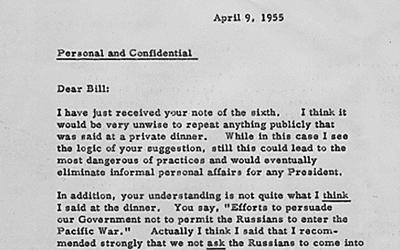
Description
This document is a typed letter from President Dwight D. Eisenhower to William D. Pawley that was sent on April 9, 1955. Eisenhower recalls a conversation he had with U.S. Secretary of War Henry Stimson about the use of an atomic bomb during World War II. Stimson told…
Letter from Dr. Luis Alvarez to his Son about the Atomic Bomb, August 6, 1945
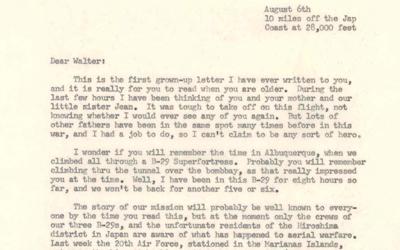
Description
This item is an unsigned, three-page typewritten letter to Dr. Luis Alvarez's son Walter, headed "August 6th, 10 minutes off the Jap coast at 26,000 feet." This part described the dropping of the atomic bomb on Hiroshima. Alvarez's work on the atomic bomb led to the…
Petition from Leo Szilard and Other Scientists to President Harry S. Truman, July 17, 1945

Description
This letter was sent to President Harry Truman by some scientists involved in the Manhattan Project following the end of the war in Europe. In the letter, the scientists outline the responsibility and concerns regarding the United States having and using atomic technology…
Interview with Robert Holmberg, Who Worked on the Manhattan Project, September 22, 2005
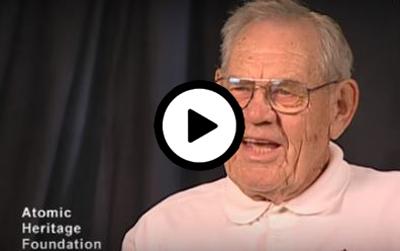
Description
Robert Holmberg was born in Fort Dodge, Iowa, and began working on the Manhattan Project at the Chicago Met Lab and at Ames Laboratory in Iowa. He was then drafted into the Special Engineer Detachment and sent to Oak Ridge, Tennessee. He continued to work on nuclear…
"Atomic Bomb Opens New Era in Scientific History" Newspaper Article, August 7, 1945
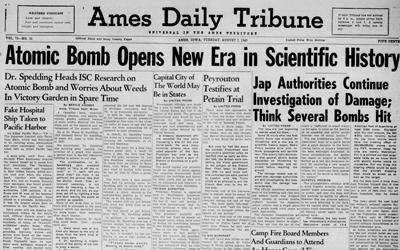
Description
This newspaper article appeared in the Ames Daily Tribune, and it "unveiled" that Iowa played a pivotal role in the development of the atomic bomb.
German Instrument of Surrender, May 7, 1945

Description
The unconditional surrender of the German Third Reich was signed in the early morning hours of Monday, May 7, 1945, at Supreme Headquarters in Reims in northeastern France. After the signing of the Reims Accord, Soviet Chief of Staff Gen. Alexei Antonov expressed concern to…
Interview of Navy Petty Officer Augustus Prince, October 20, 2004

Description
In the video, Augustus Prince recalls his service in World War II 60 years after he served in the Navy. Prince clearly recalls his being accepted as a radar man aboard the USS Santee, knowing in retrospect what that acceptance meant to him, a young African-…
“Their Cry is Answered," July 25, 1940
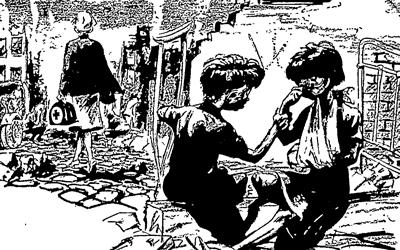
Description
The cartoon from The Pella Chronicle depicts events occurring in Europe over a year before the United States entry into war. The role of the Red Cross is highlighted in the image and shows the increasing destruction occurring in Europe.
Atlantic Charter, August 14, 1941
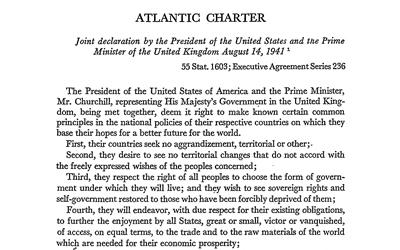
Description
This declaration is the Atlantic Charter, which was a pivotal policy statement issued during World War II by President Franklin Delano Roosevelt and Prime Minister Winston Churchill. The leaders of the United Kingdom and the United States drafted the work and all the…
USS West Virginia on Fire during Attack on Pearl Harbor, December 7, 1941

Description
This black and white photograph shows the aftermath of the bombing of Pearl Harbor, Hawaii, with the USS West Virginia shown on fire in the harbor. Disregarding the dangerous possibilities of explosions, United States sailors are seen manning their boats at the side of…
President Franklin Delano Roosevelt's "Day of Infamy" Speech, December 8, 1941
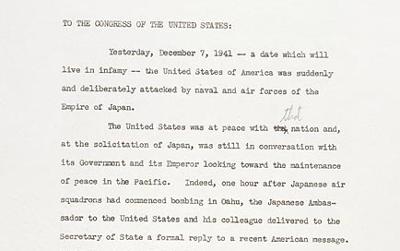
Description
On December 8, at 12:30 p.m., President Franklin Delano Roosevelt addressed a joint session of U.S. Congress, and via radio, the nation, regarding the attack on Pearl Harbor, Hawaii the day before. The U.S. Senate responded with a unanimous vote in support of war, with only…
"United States Is At War But Citizens Are Calm" Newspaper Article, December 10, 1941
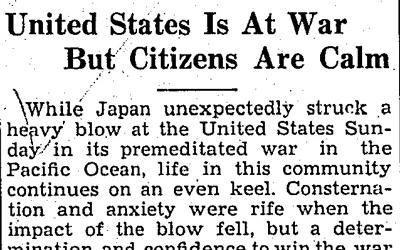
Description
The article in the Postville Herald described the impact of World War II on life in the early days of the war. In addition, as typically done in small town news publications at the time, all of the soldiers stationed at Pearl Harbor were listed. …
"Many Local People in Pacific War Zone" Newspaper Article, December 11, 1941
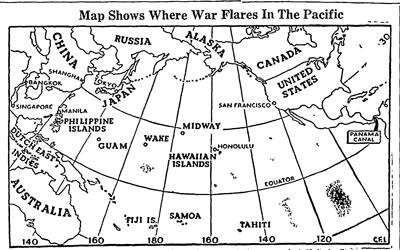
Description
This article from the Pocahontas Record-Democrat in Centerville, Iowa, shows a map of the Pacific theater during World War II. The article lists local residents who were serving in some capacity in the Pacific.
"Warning Our Homes Are In Danger Now," 1942
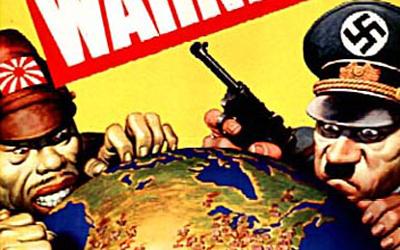
Description
Propaganda posters during World War II by public relations specialists who were advising the U.S. government believed that the most effective war posters were the ones that appealed to the emotions. The poster shown here, produced by General Motors Corporation, played on the…
"The Unconquered People" Sketch, July 1942
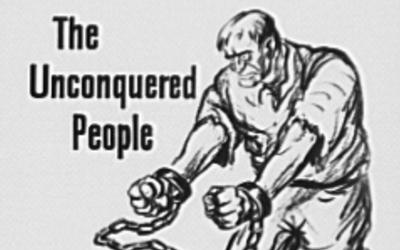
Description
The U.S. Office of War Information (OWI) published this 12-page pamphlet after the U.S. had entered World War II. The sketch shown above is of "The Unconquered People," and describes the European resistance to Adolph Hitler and Germany on the part of people in the occupied…
"Remember Pearl Harbor - Work - Fight - Sacrifice!!" 1943
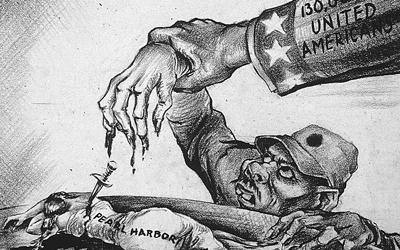
Description
This political cartoon was created by the U.S. Department of War following the events at Pearl Harbor. The illustration shows Lady Liberty (with the words "Pearl Harbor" written on her) stabbed in the back by a Japanese soldier. The Japanese soldier's hand is being lifted…
"Roosevelt and Hitler" Buster Ezell's World War II Song, March 1944
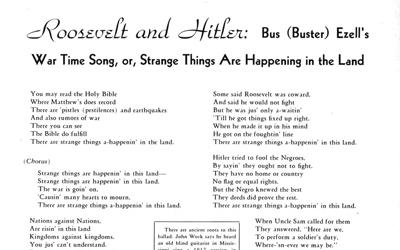
Description
This song was written during World War II. John Work arranged the song with Bus Ezell. Bus Ezell heard an old blind guitarist in Mississippi sing a 1917 version of this song, in which President Woodrow Wilson and the German Kaiser were the chief protagonists. The refrain is…
Destruction of a Burmese Village after a Japanese Bombing, ca. 1942
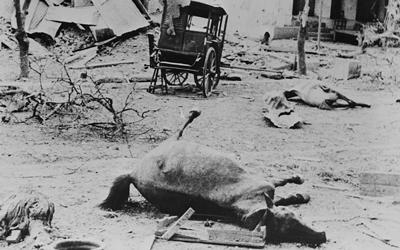
Description
The black and white photograph shows the destruction caused by a Japanese bombing raid that struck a Burmese village. The caption of the image from the war department stated, "(t)here was no military objective in this happy Burmese village. The object of the savage…
Japanese Plane Carrier Circling to Avoid Attack at Midway, June 1942
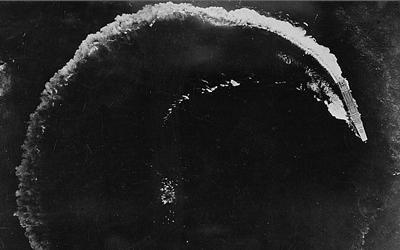
Description
The image shows a Japanese carrier circling to avoid a U.S. attack during the Battle of Midway between June 4-7, 1942. This battle took place six months after the attack on Pearl Harbor, Midway began with a Japanese attack and ended with a decisive U.S. Naval victory. …
Memo from Joseph Stalin about Opening of Second Front during World War II, August 13, 1942

Description
In August 1942, Roosevelt appointed W. Averell Harriman to represent the United States at a conference with British Prime Minister Winston Churchill and Soviet Union leader Joseph Stalin. The Moscow Conference sought a common understanding of Soviet and Anglo-American…
Allied Civilian Relief in Tunisia, 1943
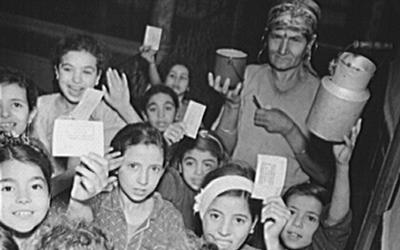
Description
The photograph shows individuals receiving aid in Mejex-El-Bab, Tunisia. A market was operated by the Allied civilian relief groups to sell food, clothing, kerosene and other supplies from the U.S. Office of Foreign Relief and Rehabilitation Operations. These items were…
Australian Troops Fighting the Japanese in Buna (New Guinea), 1944
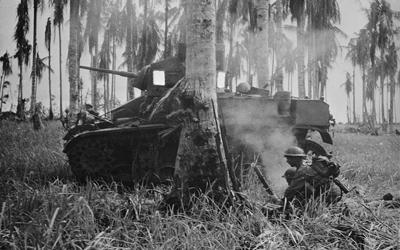
Description
In this assault in Buna, American light tanks, manned by Australian crews, smashed through Japanese pillboxes. In this photograph, taken during the actual fighting, an Australian mortar crew has fired on enemy troops 150 yards away fleeing from a busted pillbox. Note the…
D-Day Statement to Soldiers, Sailors, and Airmen of the Allied Expeditionary Force, June 1944
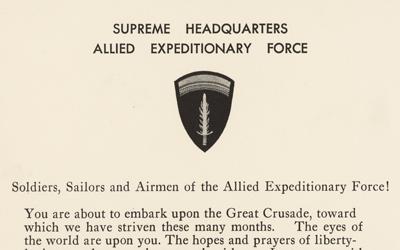
Description
This document was the written statement from General Dwight D. Eisenhower that was delivered on the eve of D-Day. The statement was written to soldiers, airmen and sailors to show the scope of military action and how significant the joint action would be.
American Troops Move Through a Bombed German Street, April 16, 1945
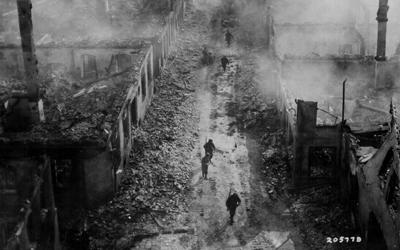
Description
This photograph shows American troops moving down a street in Germany at the end of World War II. The photo shows the aftermath of fighting in an urban area.
Interview with Merrill's Marauders Commando Grant Jiro Hirabayashi, June 29, 2005
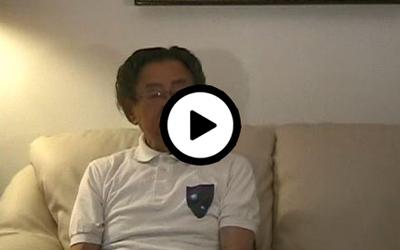
Description
This video interview is with Grant Jiroo Hirabayashi, who was one of the famed commandos of Merrill's Marauders. This was a unit of soldiers who slogged their way through the Burmese jungles to overcome the Japanese occupiers, and consisted of a number of Japanese Americans…
Interview with Conscientious Objector Rothacker Smith, March 24, 2006

Description
A conscientious objector, Rothacker Smith, served in the 366th Infantry Regiment as a medic during World War II. The 366th shipped out to Italy but was assigned to guard duties, making Smith's life as a medic a fairly easy job. When they were attached to the 92nd Division…
Nagasaki, Japan, After the Atomic Bomb, 1945
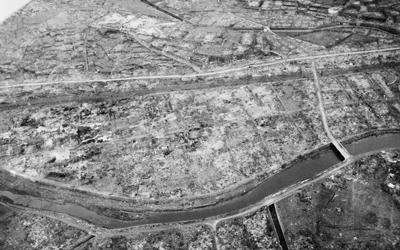
Description
This photograph shows an aerial view of Nagasaki, Japan, after American forces dropped an atomic bomb on the city. The city was bombed on August 9, 1945, and the Japanese surrendered on September 2, 1945.
General Leslie Groves' Statement to the Officers about the Atomic Bomb, 1945
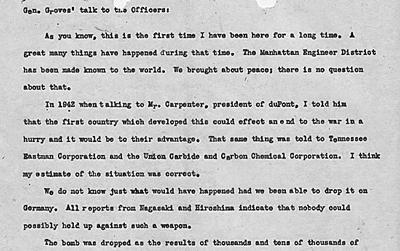
Description
General Leslie Grove was the director of the Manhattan Project. In this document, he explained to his soldiers the necessity of the atomic bomb to hasten the end of World War II.
Additional Resources
- World War II Casualities List
This database by the National Archives allows the viewer to search for World War II casualities of Iowans by county. - "Atomic Bomb Opens New Era in Scientific History"
This Wordpress website by Iowa State University Special Collections and University Archives includes newspaper clippings, photographs and more that show the connection between ISU and the invention of the atomic bomb. - "The War" by Ken Burns and Lynn Novick
This is the main webpage for the PBS documentary "The War," which provided a vast overview of America on the homefront and battlefront during World War II. - Voices of the Manhattan Project
This website produced by the Atomic Heritage Foundation contains a number of oral histories from individuals who had some part in the Manhattan Project to create the first atomic bomb. - IPTV's "World War II"
This Iowa Pathways website "World War II" includes a number of primary and secondary resources and links featuring Iowans who experienced World War II.
Iowa Core Social Studies Standards (9th-12th Grade)
Listed below are the Iowa Core Social Studies content anchor standards that are best reflected in this source set. The content standards applied to this set are elementary-age level and encompass the key disciplines that make up social studies for students 9th through 12th grade.
| No. | Standard Description |
| SS-Geo.9-12.17. | Analyze how environmental and cultural characteristics of various places and regions influence political and economic decisions. |
| SS-Geo.9-12.20. | Assess the impact of economic activities and political decisions on urban, suburban, and rural regions. |
| SS-US.9-12.20. | Analyze the growth of and challenges to U.S. involvement in the world in the post-World War II era. |
| SS-US.9-12.22. | Evaluate the impact of inventions and technological innovations on the American society and culture. |
| SS-US.9-12.24. | Critique primary and secondary sources of information with attention to the source of the document, its context, accuracy, and usefulness such as the Reconstruction amendments, Emancipation Proclamation, Treaty of Fort Laramie, Chinese Exclusion Act, Roosevelt’s Corollary to the Monroe Doctrine, Wilson’s Fourteen Points, New Deal Program Acts, Roosevelt’s Declaration of War, Executive Order 9066, Truman Doctrine, Eisenhower’s Farewell Speech, Gulf of Tonkin Resolution, Test Ban Treaty of 1963, Brown vs. Board of Education decision, Letter from a Birmingham Jail, and the Voting Act of 1965. |
| SS-US.9-12.26. | Determine multiple and complex causes and effects of historical events in American history including, but not limited to, the Civil War, World War I and II, the Korean War and the Vietnam War. |
| SS-US.9-12.27. | Evaluate Iowans or groups of Iowans who have influenced U.S. History. |
| SS-WH.9-12.18. | Assess impact of conflict and diplomacy on international relations. |
| SS-WH.9-12.23. | Critique primary and secondary sources of information with attention to the source of the document, its context, accuracy, and usefulness of sources throughout world history. |
| SS-WH.9-12.25. | Determine multiple and complex causes and effects of historical events within world history. |
| SS-WH.9-12.26. | Assess Iowans or groups of Iowans who have influenced world history. |